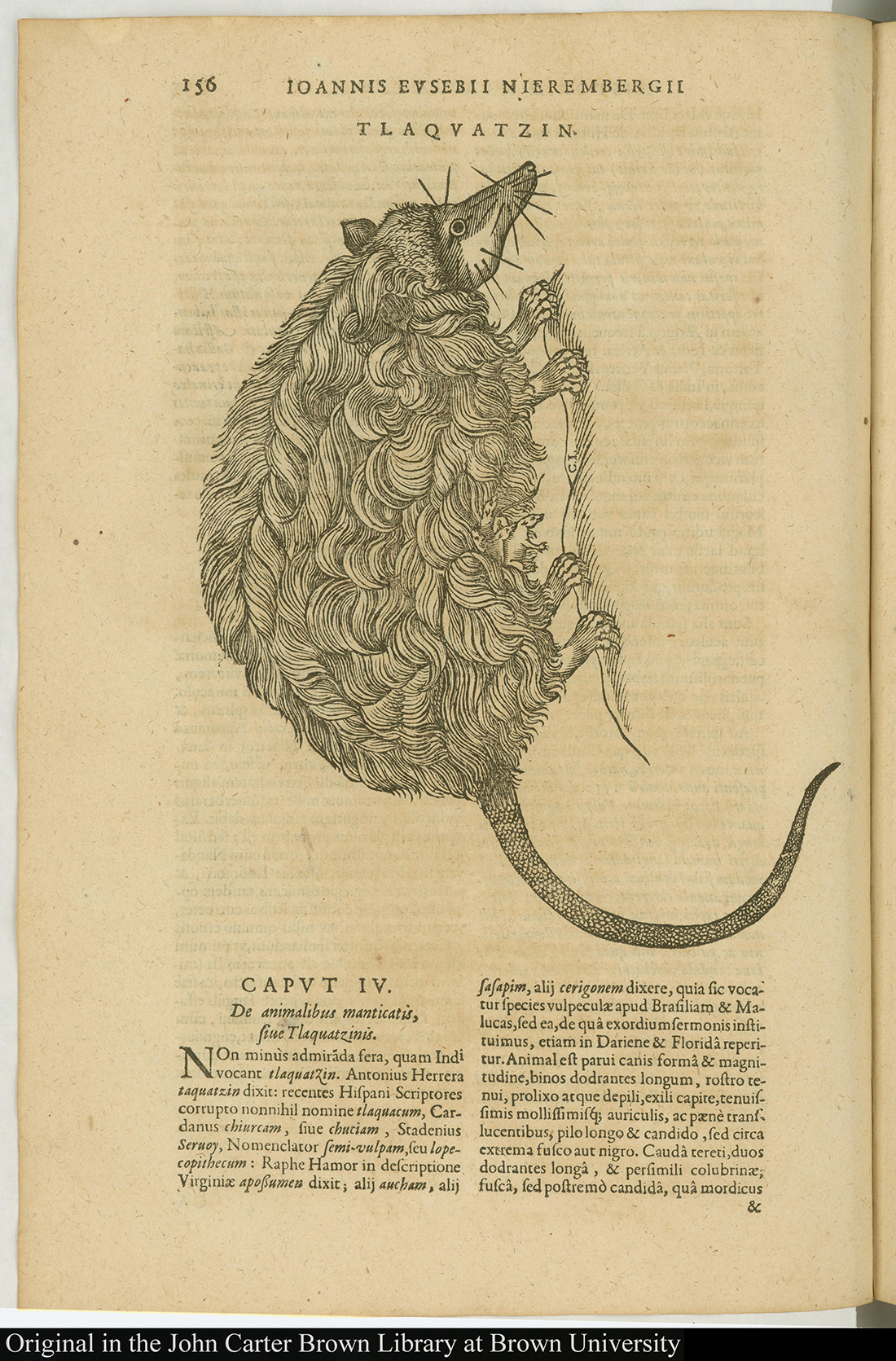Of the long list of novel creatures featured in early modern descriptions of the New World, the opossum stands out as particularly curious. On the one hand, numerous testimonies point to the opossum’s ‘composite’ or ‘chimerical’ appearance, conventionally referring to it as ‘monstrous’. Thus Spanish explorer Vicente Yáñez Pinzón (1462– 1514), whose account is regarded as one of the earliest, refers to it as a ‘Monster, the foremost part resembling a Fox, the hinder a Monkey, the feet were like a Man’s, with Ears like an Owl’. Of particular interest to the history of the opossum as an object-image of knowledge is the treatise entitled Historia naturae, maxime peregrinae by the Spanish Jesuit scholar Juan Eusebio Nieremberg (1595–1658). Nieremberg presents and contrasts a number of descriptions of the opossum, which he calls by its Nahuatl name tlaquatzin/tlacuatzin, starting with materials compiled by Francisco Hernández (1514–87). Nieremberg presents a new illustration of the opossum that represents a female tlacuatzin and her offspring.
OPOSSUM
Opossum (tlaquatzin) in J.E. Nieremberg, Historia naturae, maxime peregrinae (Antwerp: Plantin-Moretus Press, 1635).
José Ramón Marcaida
Further reading
- Asúa, M., and R. French (2005) A New World of Animals: Early Modern Europeans on the Creatures of Iberian America (Burlington, VT: Ashgate).
- Bleichmar, D. (2017) Visual Voyages: Images of Latin American Nature from Columbus to Darwin (New Haven, CT: Yale University Press).
- Egmond, F. (2017) Eye for Detail: Images of Plants and Animals in Art and Science, 1500–1630 (London: Reaktion Books).
- Marcaida, J.R. (2014) Arte y ciencia en el Barroco español: historia natural, coleccionismo y cultura visual (Madrid: Fundación Focus-Abengoa/ Marcial Pons Historia).
- Mason, P. (2009) Before Disenchantment: Images of Exotic Animals and Plants in the Early Modern World (London: Reaktion Books).
- Millones Figueroa, L., and D. Ledezma (eds.) (2005) El saber de los jesuitas, historias naturales y el Nuevo Mundo (Madrid/Frankfurt am Main: Iberoamericana/Vervuert).
- Pardo–Tomás, J. (2016) ‘Making natural history in New Spain, 1525–1590’, in The Globalization of Knowledge in the Iberian Colonial World, edited by H. Wendt, 29–51 (Berlin: Max Planck Institute for the History of Science Berlin).
- Parrish, S.S. (1997) ‘The female opossum and the nature of the New World’, William and Mary Quarterly, 54 (3): 475–514.
- Pimentel, J. (2009) ‘Baroque natures: Nieremberg, American wonders and preterimperial natural history’, in Science in the Spanish and Portuguese Empires, 1500–1800, edited by D. Bleichmar De Vos, K. Huffine, and K. Sheehan, 93–111 (Stanford, CA: Stanford University Press).
- Slater, J., M.L. López Terrada, and J. Pardo–Tomás (eds.) (2016) Medical Cultures of the Early Modern Spanish Empire (London: Routledge).





